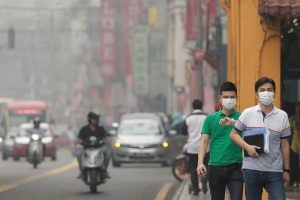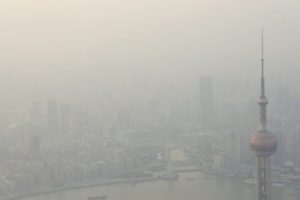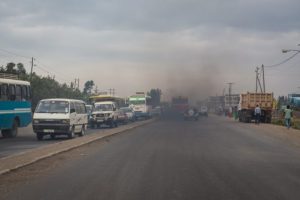Outdoor air pollution is an increasingly important risk factor for lung cancer among former and never-smokers. Though the global prevalence of smoking has decreased in recent decades, lung cancer remains the most common cause of cancer death, killing about 1.7 million people each year.

Pedestrians wearing face masks due to air pollution in Kuala Lumpur, Malaysia
And as air pollution levels continue to climb in urban centers of many low- and middle-income countries, we are beginning to see a global shift in the causes of lung cancer cases. There is an urgent need to not only raise awareness of air pollution as a cause of lung cancer, but to explore how public health control strategies for tobacco might be applied to control of air pollution.
While air pollution is a complex mix of gases and aerosols (suspended solid and liquid particles), the most measured and important pollutant of concern is particle pollution, also called particulate matter (PM), which manifests as dust, soot, smog, or smoke. Fine particulate matter, also known as PM2.5, or particles less than 2.5 microns across, has the largest impact on public health globally. PM2.5 is produced directly from combustion of a variety of carbon-based fuels, but it can also be produced in chemical reactions between pollutants already in the atmosphere. Vehicle exhaust, industrial emissions, solid fuel use, and refuse burning are some of the most common sources of PM2.5 air pollution in urban centers across the world.

Heavy air pollution over Shanghai, China
Regardless of the source, the resulting pollution has clear and devastating impacts on human health. As early as 1952, a “Great Smog” that covered the city of London for 5 days led to at least 8,000 premature deaths and was deemed Europe’s worst air pollution crisis ever. Over 60 years later, in 2013, the International Agency for Research on Cancer (IARC) classified particulate matter in outdoor air pollution as a human carcinogen. Even more recently, in 2017, experts on global disease burden reported that outdoor air pollution is one of the top global causes of premature death, killing about 4.2 million people in 2015. That is about 1 million more deaths than are caused by AIDS, Malaria, and tuberculosis in the same year, combined.
While most of the 4.2 million premature deaths linked to air pollution are from heart disease and strokes, about 42% (around 1.7 million deaths) are from lung cancer and other respiratory diseases. Furthermore experts estimate that ambient PM2.5 air pollution is responsible for up to 16.5% of the estimated 1.7 million lung cancer deaths worldwide.
Though available evidence shows smokers and non-smokers alike are harmed by air pollution, some recent studies are perhaps most concerning for nonsmokers who might have thought themselves safe from lung cancer: one 26-year longitudinal study of a cohort of never-smokers in the US found that for every increase of 10 micrograms per cubic meter of particulate matter pollution, lung cancer mortality risk rises by up to 27%. This finding suggests that the risk to non-smokers could be considerably greater in major cities around the world like Beijing and Delhi, where average annual PM2.5 levels are several-fold higher than in the US cities studied.
Researchers are also exploring outdoor air pollution’s association with non-lung cancers as well. Some studies have found an association between particulate matter pollution, nitrogen dioxide, and ozone with kidney, bladder, and colorectal cancers. Another study reports that traffic-related air pollution exposure to unborn children and infants is associated with a variety of childhood cancers including leukemia and retinal cancers.
An individual’s risk of developing lung cancer from smoking tobacco is of course far higher than the risk from living in a city with polluted air. However, because so many more people are exposed to air pollution than to tobacco smoke, the total population burden from air pollution is high. Though most lung cancer cases are a result of smoking tobacco, up to 15% occur in individuals who have never smoked.
The evidence that air pollution is a risk factor for cancer, chronic lung disease, and cardiovascular disease is unsurprising and similar to already well-understood mechanisms and health risks of exposure to secondhand tobacco smoke. Tobacco smoke particles and outdoor PM2.5 pollution share some similar chemical compounds and mechanisms of disease, such as polycyclic aromatic hydrocarbons—or PAHs—and their role in cancer causation. In fact, the similarities in effects of PM2.5 exposure from different sources—ambient and household air pollution, active smoking and environmental tobacco smoke—are so striking that researchers are combining evidence from studies of these sources to estimate the global burden of disease from air pollution.
Greater Risks in Poorer Countries
Air pollution levels remain high and are increasing in many low- and middle- income countries. Rapid development is leading to a rise in ‘modern’ pollution sources, such as industry, power generation and motor vehicles. At the same time, underdeveloped infrastructure in these countries leaves large populations without access to clean, modern household energy and dependent on smoky solid fuels such as wood, coal, and other biomass fuels for indoor heating and cooking, thereby threatening the health of smokers and non-smokers alike. In addition to the devastating impacts of smoke pollution from solid fuels—nearly 3 million deaths annually—household solid fuels cause 25-40% or more of outdoor PM2.5 pollution in parts of Africa and South Asia. Uncontrolled burning of trash, long since banned in most wealthy countries, is a widespread problem in the developing world.

Motor vehicles are a major source of air pollution in Addis Ababa, Ethiopia
Successful Strategies
There are proven solutions to addressing the global air pollution crisis that particularly affects low- and middle-income countries. These countries need assistance to rapidly and cost-effectively adapt best practices and technologies developed in wealthy countries, including successful air quality management systems and subsidies to accelerate access to clean, modern household energy, clean vehicle technologies and fuels, and modern waste management and agricultural practices to replace open burning. To accelerate progress, the kind of strong civil society advocacy that has driven environmental protection in the past needs to be nurtured.

Clean energy sources include solar and wind power
Urban residents need to be educated about the dangers of air pollution and its documented associations with cancers and other health outcomes. Successful strategies employed in tobacco control over the past few decades can inform these efforts. The use of graphic messages with emotional content, rather than just facts and statistics, has been successful in changing perceptions of smoking related risks. Successful campaigns for smoking bans in restaurants and public places have championed people’s right to breathe air free from smoke pollution. Both approaches should be tested, tailored and applied to communicating about the harm of air pollution.
Progress on tobacco control also involved investigating and identifying deceptive and unethical industry practices. While air pollution is more complex, the power, motor vehicle, coal and industrial sectors have all played a role in delaying the introduction of regulations and available technology that could greatly reduce harmful emissions.
Finally, as with tobacco control, governments struggling to strengthen health care systems and address the rising burden of non-communicable disease should consider imposing more taxes, fees and fines on polluting activities to recoup some pollution-related health costs while incentivizing cleaner technologies.
Though progress has been slow, political will is growing in many countries. For example, Dhaka, Bangladesh has recently seen a commitment to partial financing of kiln modernizations, which are currently believed to be responsible for 40% of the city’s particulate air pollution. The Government of Cameroon recently announced the adoption of a national master plan to increase the use of clean fuels to 58% of the population by 2030. And in Krakow, Poland, the government is currently offering reimbursement and subsidies for shifting residential heating systems from coal to gas.
As the threats to human health evolve, so must our responses. The increasing lung cancer risk for nonsmokers posed by outdoor air pollution shows that smoking bans do not truly make cities “smoke free” or prevent all health harm from breathing smoke-polluted air. In the words of a researcher discussing recent findings linking air pollution to weaker bones, “Air pollution is diluted smoking”. Combatting air pollution—a threat that transcends social, political, and geographical boundaries—requires a collective reaction from the public, health scientists, policy makers, and industry. Civil society movements for tobacco control, clean air action, clean household energy access and combatting climate change should all find common cause in promoting the right to breathe smoke-free air.
CityHealth Perspective is a blog series that examines the importance of urban policies and environments on public health. Urban interventions are a strategic focus for our work and a core strength of our team. With the majority of the world’s population now urban and an additional 2.5 billion urban dwellers anticipated by 2050, we believe that public health must play a stronger role in shaping future cities that advance human and planetary health.